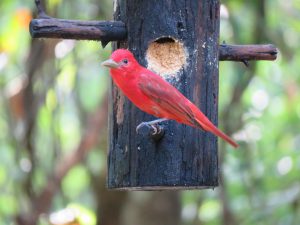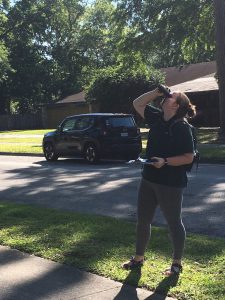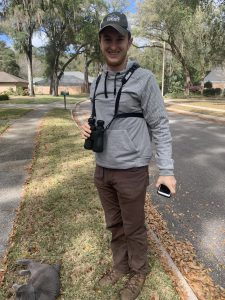By Katrina Rossos
Often ignored, cities contain many small forest fragments and residential areas that offer tree canopy cover and a variety of native plants, which are both ideal environments for an array of species.
“It’s evolved over the past 20 years, but probably my major focus has been that cities matter in terms of regional biodiversity,” said Mark Hostetler, professor within the Department of Wildlife Ecology and Conservation and a UF/IFAS Extension Specialist.

Hostetler’s research focuses on how cities can be planned and managed to maintain species richness. His work informs city planners and residential developers about how to optimize neighborhood design and educates the public on how to properly landscape to provide habitat for birds and other wildlife. This includes “re-wilding” portions of a yard and paying close attention to identifying and removing invasive plants so they do not spread to nearby natural areas.
A city’s natural expanses must be protected to certify long-term conservation of many different species – particularly birds. Jan-Michael Archer (SNRE MS ’16), a former student of Hostetler, conducted a systematic review of birds that use fragmented forest and neighborhoods in cities throughout North America. The study uncovered that more than 250 species exploit these habitats. Since then, Hostetler has conducted a number of workshops and public lectures to get the word out that even one big tree or small patch of forest is extremely beneficial to birds in urban areas.
Hostetler’s current lab members, WEC MS students Ryan Buron and Natalie Pegg, are investigating how migrating and resident birds depend upon urban forest fragments and tree-rich neighborhoods within city limits – and they’re using Gainesville as the backdrop.
NATALIE PEGG

Natalie Pegg joined the Hostetler lab in Fall 2020. Her master’s research is about the distribution and habitat use of
forest birds in residential areas. Pegg is focusing on non-migratory pileated woodpeckers as well as summer tanagers and northern parulas, which migrate along the Atlantic flyway.
Existing literature out of the northeastern United States cites these species as “interior forest specialists”, which are birds that require expanses of mature forest during breeding season to reproduce successfully. However, summer tanagers, pileated woodpeckers, and northern parulas have all been spotted within residential neighborhoods in Gainesville during breeding season. Therefore, the observational evidence of these species in neighborhoods during spring suggests that their breeding requirements might vary regionally. So, Pegg is analyzing the distribution of these species in Gainesville to determine the vegetation characteristics of yards and neighborhoods that attract these birds during breeding season.
“This research is important because if these birds are behaving differently in the southeastern United States than they are in other parts of their ranges, conservation strategies would also have to be different,” Pegg explained. “By understanding what is attractive to the birds in these suburban areas, city planners, land managers, and private landowners could be given strategies on how to help protect native bird habitat.”
Pegg is surveying for the birds by walking at various locations within neighborhoods for a specific amount of time and recording the position of species observed. Then, she will assess the habitat type where the birds are seen by rating it based on the amount of vegetation within five meters of the bird. This classification will help Pegg gauge the species’ fine-scale habitat selection.
The foliage will then be analyzed on a broader scale to understand species distribution within the study locations. She will estimate tree canopy cover (where northern parulas and summer tanagers hunt for insects), dead trees (where pileated woodpeckers create large cavities for nesting), and Spanish moss hanging off branches (which northern parulas use to make nests). This exploration will determine whether or not the birds are choosing more forested yards with increased vertical structure or if they use all types of yards.
“I hope to determine if these birds are consistently in heavily treed residential areas, but more importantly, what is catching their interest within these neighborhoods that makes them keep returning there,” said Pegg.
Accounting for these variables will determine why these species breed in southern neighborhoods with lots of trees. Pinpointing the requisite habitat needs for a favorable mating period for these species will inform private landowners, land users, and city planners on how to conserve these features.
RYAN BURON

Ryan Buron, who is slated to graduate this summer, joined the Hostetler Lab in 2019. His master’s research focuses on migrating and wintering birds and how they use urban forest fragments versus nearby residential areas that contain pockets of tall woodland to see if different species prefer foraging in one environment over the other. He is also determining the site characteristics, in terms of tree canopy cover and vertical height structure, to explain habitat use. Buron identified five study areas within Gainesville that incorporated forest fragments of at least 20 acres and compared them against adjacent neighborhoods.
“As urban areas are rapidly increasing, there is a need to study small-scale habitat preferences within the urban matrix,” said Buron. “My goal is to identify important habitat characteristics for species using urban habitats during migration and winter seasons.”
Rather than keying in on certain bird species, he is assessing how all migrating and overwintering birds exploit these habitats. In this regard, Buron can identify which species use urban forest fragments, residential areas, or both.
Buron hypothesizes that vegetation disparities between forest fragments and residential neighborhoods drive habitat preference. Neighborhoods contain less vegetation under the tree canopy because of homes and more manicured landscapes. Various bird species forage and nest from different parts of a forest’s vertical structure, which includes the canopy, middle (mid-story and under-story), and ground. For instance, a canopy-affiliated species is the northern parula and a ground-affiliated species is the ovenbird. Buron anticipates species that primarily utilize the canopy will occupy neighborhoods with tall trees and urban forest fragments equally, and birds that primarily utilize the ground and understory will be most often found within urban forest fragments.
Migratory habitat are the stopover sites where birds settle and rest during their spring and fall journeys. The interior forest specialists who require large expanses of breeding habitat do not need vast migratory habitat for stopover. Even small sections of tree cover is enough space to replenish their energy to continue their long migration between their breeding and wintering grounds.
“This study hopes to show that conserving these small fragments and residential areas with tree canopy can be important during this migration period,” said Buron.
Stopover for traveling birds is brief and migrating birds follow staggered timelines. Therefore, to ensure he saw as many species as possible as they passed through Gainesville in waves, Buron conducted 10-minute, 50-meter point count surveys in the urban forest and neighborhoods for four hours after dawn on every clear-skied day in the fall and spring. He stood in one location and tallied all the migrating bird species he observed within a 50-meter radius in all directions over 10 minutes. Buron accounted for habitat preference by noting vegetation disparities, such as canopy cover, vertical height structure, or amounts of undergrowth.
Overall, Buron identified 44 different migratory species during his field work. He modeled the birds against habitat preference for each species and created a comprehensive model that contained all migrating species. The data substantiated his hypothesis that some ground and mid-story foraging birds favor urban forest fragments. Also, many migrants utilized both the residential areas and the forest fragments. This evidence shows that preserving urban forest and trees within neighborhoods improve stopover habitat for a diversity of migrants.
Armed with this information, Buron strives to apprise city planners and residential developers on how to create bird-friendly spaces. Developers that clear-cut forests and replace trees with lawn or sidewalks are doing these birds a disservice.
“We hope that this study will help inform urban planners and designers about the importance of conserving small fragments and residential vegetation,” Buron said. “It takes time and money to implement these habitat features into urban habitats, but we hope to show the benefit of these things. I mean, who doesn’t want to see migrating birds passing through your neighborhood?”
 1
1
